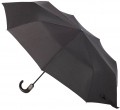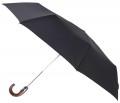Frame material
The material from which the umbrella frame is made. The frame in this case means mainly the central rod, however, the spokes are often made of the same material — unless otherwise indicated in the characteristics (see "Spoke material").
—
Steel. One of the most popular options among modern umbrellas. Steel allows you to provide good indicators of strength and elasticity. It is worth noting that different types and grades of this material can be used in umbrellas, so the actual characteristics of a particular steel frame are directly related to the price category of the product. However, steel is used even in high-end premium models. Of its "global" shortcomings, one can only note a rather large weight.
—
Aluminium. Aluminium alloys used in umbrellas are noticeably lighter than steel, but less durable. They can also have different characteristics, usually directly related to the price category of the respective model, however, in general, this material is considered less reliable, and therefore is found mainly in entry-level and mid-level umbrellas.
—
Fiberglass. Material based on glass drawn into thin threads. It has little in common with ordinary window glass: it is highly durable, does not break, and bends well without damage. Actually, flexibility is one of the main advantages of fiberglass — it is this material that is often used in
...storm umbrellas(see above), because. such knitting needles easily endure repeated turning inside out and back.
— Fiberglass. A polymeric material combining the fiberglass described above with a plastic base. It costs much less than pure fiberglass, but loses to it in terms of performance, which is why it is found mainly in inexpensive models of umbrellas.
— CFRP. A composite material that combines fine carbon fiber fabric and a plastic base. Differs in extreme durability — some grades surpass even steel — at the same time it weighs very little; on the other hand, the cost of CFRP is quite high. As a result of all this, this material is used quite rarely in umbrellas, mainly among luxury products.
— Tree. Wood has a pleasant appearance, but is inferior to metal in strength. Therefore, it is used mainly as a design material in some cane umbrellas (see "Type") — and even then in such models only the central rod is usually made of wood, the rest of the parts are made of metal.
— Plastic. Pure plastic is poorly suited for the manufacture of frames for umbrellas: it is not strong enough and resistant to stress for this. Therefore, this option can only be found in the most inexpensive models, as well as in children's umbrellas (see "Purpose"), for which light weight and the absence of sharp edges are more important than high strength.
Note that some models can be equipped with combined frames: for example, the central rod is made of steel, and the spokes are made of fiberglass. This is usually indicated in the specifications.Number of spokes
The number of spokes provided in the umbrella frame. Theoretically, the more spokes, the stiffer and more reliable the frame. At the same time, the actual properties of the product are largely determined by other factors — the material of the spokes and the dome, their design features, the general type of umbrella (see above), etc. Therefore, we can say that in most cases the number of spokes is a purely reference parameter that does not have a noticeable effect on performance.
Dome diameter
The diameter of the umbrella dome when unfolded. The larger the diameter of the dome, the more reliably it will protect you from rain and the easier it will be to place one more person under the umbrella. On the other hand, a wide umbrella can be uncomfortable in tight spaces — for example, in the flow of pedestrians on a busy street — and when folded it will take up more space. Therefore, it does not always make sense to choose the largest of the available options.
The minimum diameter for an "adult" umbrella (see "Destination") is considered to be about 80 cm. Most models are in the range of 90 – 110 cm — this provides a good degree of protection with ease of movement. And in
the largest modern products, the diameter of the dome can reach 150 cm.
Length (folded)
The length of the umbrella when folded. For the decomposed one, this parameter is not specified, because is not critical, but when transporting a closed umbrella, it is the length that is the most important dimension.
The length of cane umbrellas (see "Type") is, by definition, the same when open or closed; most often it is 60 – 90% of the dome diameter (see above). But folding models of the same diameter can vary markedly in length, and here the choice depends on the situation: on the one hand, more compact umbrellas are more convenient to carry, on the other hand, they are less reliable and more complex in design, and also cost more.
Handle material
—
Plastic. As a material for umbrella handles, plastic is very practical: it has a low price, is resistant to moisture, and its strength, although lower than that of metals, is quite sufficient in this case, especially since there are many varieties of this material on the market, including number and are very durable. It is also worth noting the low thermal conductivity of plastic — it does not "cool" the hand in cool weather. Similar handles are used in umbrellas of all price categories.
—
Tree. Wood, like plastic, does not conduct heat well and does not cool the hand, while many consider it more pleasant to the touch; Yes, and this material looks quite stylish. At the same time, wooden handles are somewhat more expensive, and their quality noticeably depends on the price category of the umbrella (although in a cheap product, the frame is more likely to break than the handle).
—
Skin. In this case, of course, we are talking about a handle made of hard material (usually wood or plastic, see above), covered with genuine leather. Such a coating gives the pen a rich and solid appearance and well emphasizes the image of the owner — after all, leather is quite expensive. Of the practical disadvantages of this option, it is worth noting the exactingness of care — otherwise the material may lose its presentation.
—
Metal. Metal handles are usually an integral extension of the central rod. They are very durable, besides they look stylish, but they tend to "cool" the hand and slip out of it — therefore they are rarely used, mainly in designer models.
— EVA foam. Handles in the form of a solid base (usually the same material as the frame), covered with a layer of ethylene vinyl acetate (EVA) foam. This coating is pleasant to the touch, does not slip in the hand and provides a secure hold. At the same time, for a number of reasons, this option is found mainly in premium models.
Clasp
The type of clasp installed on the umbrella strap.
We are talking about a strap that tightly secures the dome in the closed position. Most often,
Velcro or
a button is used as a fastener, and in some models a button is used. Here is a description of each option:
- Velcro. The most popular type of fastener these days. Velcro is inexpensive, extremely compact (in particular, it does not protrude above the strap, unlike buttons), and is also easy to use - so they can be found in all price categories of umbrellas. The main disadvantage of such devices is that as they wear out, their effectiveness drops noticeably - to the point that at one point the Velcro stops holding it at all. However, the service life of such fasteners is still usually quite long, and worn-out Velcro can be replaced without any problems or costs in a workshop or even on your own.
- Button. The clasp is in the form of a characteristic metal button, like clothing buttons. Such devices are much more reliable and durable than Velcro, but they are more expensive and somewhat less convenient: unfastening the button requires a certain amount of force, and fastening it also requires greater precision. In addition, not all users like the part that noticeably protrudes from the strap when the umbrella is closed. In light of this, buttons are used much less often than Velcro, and mainly in models of the middle
...and top price categories (with rare exceptions).
- Button. An ordinary button that, when fastened, is threaded into a loop. From a practical point of view, such fasteners are noticeably inferior to Velcro and buttons - they are not as reliable, and they are not particularly convenient. Therefore, buttons can be found extremely rarely in our time - in individual cane umbrellas in the “retro” style, where such a fastener is used primarily as a characteristic design element.Weight
Total weight of the umbrella.
All other things being equal,
lighter umbrellas are more convenient to carry (both in the open and closed positions). On the other hand, such products are less reliable and/or more expensive than relatively heavy models of similar design and size. We also note that in some cases, significant weight can be an advantage. For example, in a strong wind, a massive umbrella does not “tear from your hands” as much, and when released, it does not fly as far as a lighter one.

